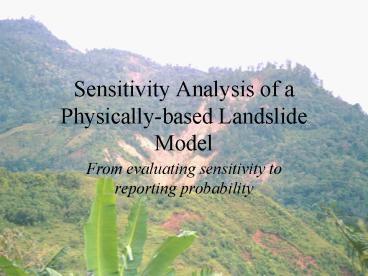Sensitivity Analysis of a Physicallybased Landslide Model PowerPoint PPT Presentation
1 / 29
Title: Sensitivity Analysis of a Physicallybased Landslide Model
1
Sensitivity Analysis of a Physically-based
Landslide Model
- From evaluating sensitivity to reporting
probability
2
A Review of Project Goals
- Identify landslide susceptible areas on the
watershed scale zones with a low Stability Index
(SI). - Evaluate the impacts of roads, structures, and
vegetation on slope stability. - Develop recommendations for slide-prone locations
and for the stabilization of open scars.
3
Infinite Slope Stability Model
D
Dw
W
T
N
f
q
4
Infinite Slope Stability Model
(Hammond et al. 1992)
Cr Cohesion due to roots f Angle of Internal
Friction Cs Cohesion due to soil D Depth
below soil surface q Slope angle Dw Depth
below water table rs Wet soil density rw
Density of Water
5
SINMAP
- Stability INdex MAPing (Pack, Tarboton, Goodwin)
- Environment ArcView extension
- Language C and Avenue
- Theoretical basis Infinite Plane Slope Stability
Model - Required Data Digital Elevation Model, Parameter
Calibration Regions, User-Defined Parameters - Stochastic Element Parameters are allowed to be
uncertain following uniform distribution between
specified limits
6
(No Transcript)
7
(No Transcript)
8
(No Transcript)
9
(No Transcript)
10
(No Transcript)
11
(No Transcript)
12
(No Transcript)
13
Why Perform Sensitivity Analysis?
- Evaluate the precision required of future field
measurements. - Assess the stability of model outcome
- Report predictions in probabilistic terms
14
(No Transcript)
15
(No Transcript)
16
(No Transcript)
17
Implemented Formula
C dimensionless Cohesion T Transmissivity R
Rate of Recharge (steady state) r density ratio
(rw/rs) a specific catchment area (flow
calculated using D? method)
18
Sensitivities of SINMAP User-Defined Parameters
- Water input (R) RainfallThroughfall
- Transmissivity(T) ConductivityDepth Flow
- Cohesion(C) Sc / (Depth Failuregsat)
- Angle of Internal Friction (f) f(Porosity)
19
A Statistical Approach
- c N(m,s2) ? C
- n N(m,s2) ? f
- log Ksat N(m,s2) ? T
- rsat N(m,s2) ? C
- Dflow Dfailure ?? ? T, C
- R constant
20
Sensitivity Response
- What constitutes sensitivity?
- Changes in the global mean.
- Variability in FS at a range of selected points.
- Total number of grid cells that lie below the
instability threshold.
21
(No Transcript)
22
(No Transcript)
23
(No Transcript)
24
(No Transcript)
25
Assessment
- 1. Precision required of future field
measurements. - Ksat and f require careful measurement, while
depth, bulk density, and soil cohesion (in
non-cemented soils) can be estimated.
26
Assessment
- 2. Stability of model outcome
- The locations of zones of predicted instability
are not sensitive to changes in calibration
parameters. The fraction of total area predicted
to be unstable, however, changes significantly at
the outer range of cumulative parameter
distribution.
27
Assessment
- 3. Reporting predictions in probabilistic terms
- Sensitivity Analysis has allowed us to generate
an Expected Probability of Failure map. This
is a considerable improvement over binary
instability maps.
28
General Conclusions
- The SA was pursued in order to reveal the hidden
instabilities of the model, and it does achieve
this end. - Additionally, a rigorous SA gives the modeler
insight to the variables that truly drive a
model. - In this case the SA has become a useful component
of results presentation, presenting the end-user
with more complete information on landslide risk
in the watershed.
29
Thank you

